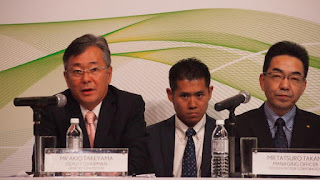Showing confidence in Malaysia’s prospects, Tatsuro Takami, right,
Toyoto Motor's managing officer, and UMW's Akio Takeyama, left,
announced a new Toyota assembly plant to double their joint venture’s
production capacity.
KUALA LUMPUR -- Toyota Motor Corporation announced on Wednesday construction of a new joint-venture assembly plant for passenger vehicles to cater to increasingly affluent Malaysian motorists.
KUALA LUMPUR -- Toyota Motor Corporation announced on Wednesday construction of a new joint-venture assembly plant for passenger vehicles to cater to increasingly affluent Malaysian motorists.
The 2-billion
ringgit ($488 million) plant will be built by UMW Toyota Motor, a 49:51
joint venture between the Japanese carmaker and its local partner, UMW
Corporation.
The
investment covers land, construction, and plant, is by far the largest
undertaken by the joint venture since its establishment in 1982. It
comes at a time when foreign direct investment (FDI) in Malaysia has
slumped because of a commodity slowdown.
FDI in
Malaysian manufacturing declined 45% year on year to 21.9 billion
ringgit in 2015, and investment from Japan, which had been a top
contributor, fell 70% to 4 billion ringgit.
Construction
of the new plant, located in the outskirts of Kuala Lumpur, is expected
to begin later this year for commissioning in 2019. It has an annual
assembly capacity of 50,000 vehicles, which matches an existing plant.
Toyota
targets Malaysian middle-income earners with Vios and Camry cars,
Innova and Fortuna multipurpose vehicles, and pick-ups. Prices start at
about 60,000 ringgit.
With a market share of
14%, Toyota is the largest marque in the non-national automotive car
segment, but competes closely with other Japanese carmakers in the top
three positions. Malaysia recorded sales of 666,674 vehicles in 2015,
making it Southeast Asia's third largest market after Indonesia and
Thailand.
"We hope to achieve higher
competitiveness," Tatsuro Takami, Toyota Motor's managing officer, told
reporters. He said the new plant will boost cost-effectiveness and
operational efficiency using advanced technology.

Comments
Post a Comment